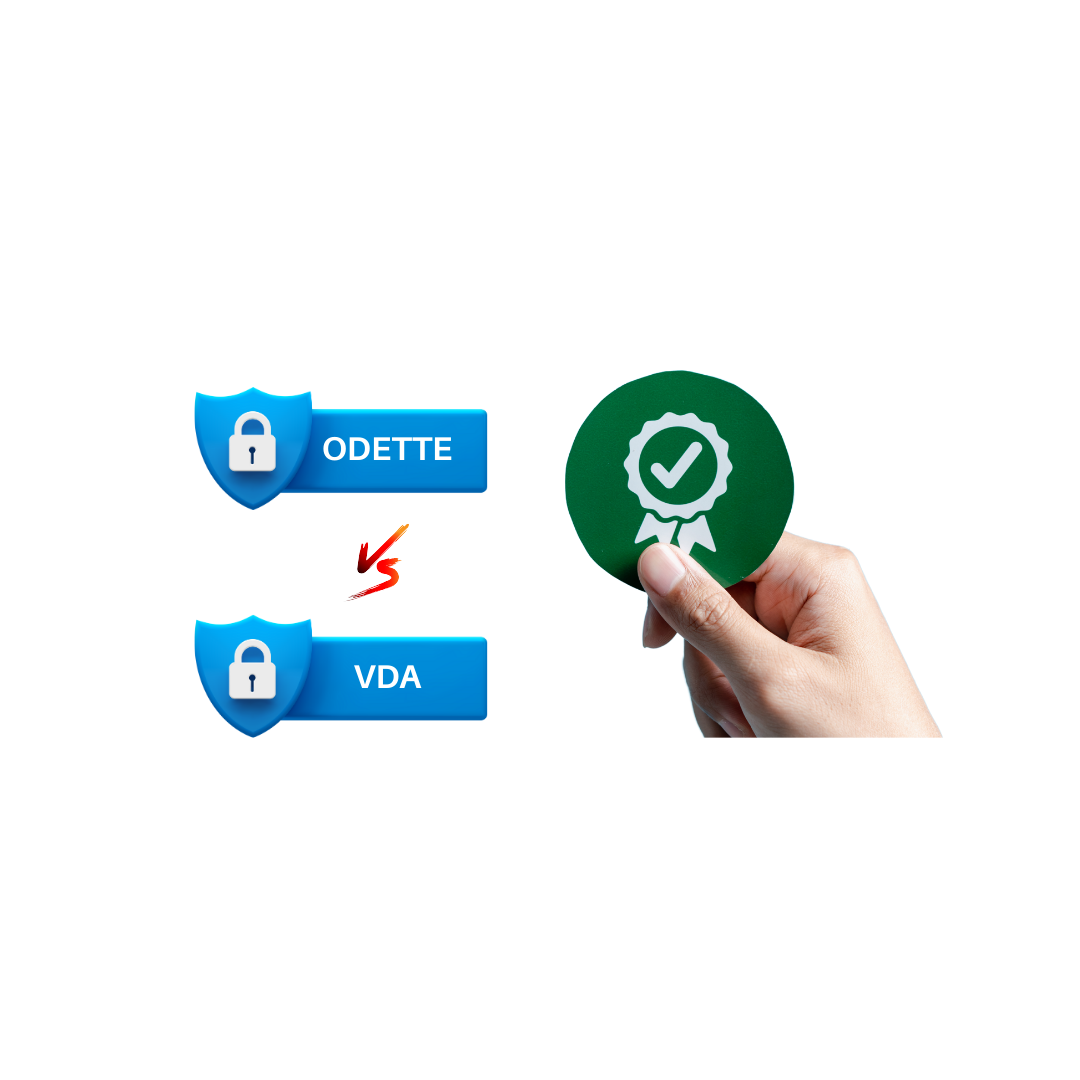Introduction
Did you know that the automotive industry has developed over thirty EDI standards specifically to meet the complex communication needs of major manufacturers? EDI standards form the backbone of modern automotive supply chains, enabling seamless data exchange between companies like VW, Audi, Bosch, Continental, and Daimler AG.
Let us explore the two critical EDI standards that drive the European automotive industry’s digital communication. The VDA EDI Standard, developed by the Verband der Automobilindustrie, provides a unified protocol for structured messages including transport labels, invoices, and delivery notes. Additionally, the ODETTE EDI Standard, created by the Organization for Data Exchange by Tele Transmission in Europe, has evolved significantly since the early 1990s from individual manufacturer systems to a comprehensive Europe-wide standard. Both systems now facilitate essential business processes such as order processing, invoicing, and shipment tracking for thousands of companies throughout the automotive supply chain.
We’ll break down how these standards work, when to use each one, and why they’re essential for anyone working within automotive logistics and supply chain management.
Understanding the Role of EDI in Automotive Supply Chains
Electronic Data Interchange (EDI) serves as the digital lifeline of modern automotive supply chains. For over four decades, this technology has been fundamental to the industry, with nearly 100% adoption among automotive companies.
Why EDI is Critical for Automotive Logistics
The staggering complexity of automotive production necessitates robust communication systems. A single vehicle comprises approximately 30,000 parts, creating an intricate network of suppliers and manufacturers. This complexity makes manual document processing practically impossible.
EDI primarily supports two critical manufacturing methodologies:
- Just-In-Time (JIT) – Focuses on delivering components exactly when needed, reducing inventory costs
- Lean Manufacturing – Eliminates unnecessary processes and non-value-adding activities
Furthermore, EDI orchestrates the entire order-to-cash lifecycle, beginning with streamlined ordering processes where OEMs use standardized transactions to requisition parts from tiered suppliers. Consequently, this cascading effect ensures transparency across tiers while Advanced Ship Notices provide visibility into incoming shipments.
The automotive industry operates in a tiered structure, with OEMs at the center surrounded by:
- Tier 1 suppliers (providing major components like suspension assemblies)
- Tier 2 suppliers (delivering components to Tier 1)
- Tier 3 suppliers and beyond (supplying smaller parts)
EDI enables these tiers to communicate seamlessly, ensuring production lines operate without interruption. Moreover, it enhances operational efficiency, reduces costs, and improves supply chain visibility.
Overview of Common EDI Standards: VDA, ODETTE, EDIFACT
Different regions have developed unique EDI standards to meet specific requirements:
VDA (Verband der Automobilindustrie) – The German automotive industry standard, widely used among German manufacturers and their suppliers. Common transaction sets include VDA 4905 (Invoice), VDA 4913 (Purchase Order), and VDA 4984 (Advance Ship Notice).
ODETTE (Organization for Data Exchange by Tele Transmission in Europe) – Primarily used throughout Europe, this standard develops tools to improve efficiency and security in automotive supply chains. OFTP2, its file transfer protocol, ensures secure data exchange over networks[20].
UN/EDIFACT (United Nations rules for Electronic Data Interchange for Administration, Commerce and Transport) – An international standard widely used in Europe and globally. Notable for its versatility across industries[20].
ANSI X12 – The primary standard in North America, with common transaction sets including 810 (Invoice), 850 (Purchase Order), and 856 (Advance Ship Notice)[20].
These standards facilitate precise inventory management and rapid responses to demand changes, ultimately supporting the complex automotive ecosystem.
VDA EDI Standard: Structure and Message Composition
The structured format of VDA EDI messages follows a precise architectural blueprint, enabling standardized communication throughout the automotive supply chain. Unlike other EDI frameworks, VDA messages organize data in a distinctive three-part structure that provides clear navigation for automated systems.
Datenkopf, Datenhauptteil, Datenschlussel Explained
Every VDA message consists of three fundamental components. The Datenkopf (data head) serves as the introductory section, containing crucial metadata including sender/receiver IDs, creation timestamps, and message type identifiers. Following this, the Datenhauptteil (data body) forms the central section where transaction-specific information resides, housing all pertinent details like quantities, dates, and item descriptions. Finally, the Datenschlussel (data foot) concludes the message, often including summary data or checksums to verify data integrity upon receipt.
T-sets and Segment Construction in VDA
T-sets (Transaction Sets) represent the backbone of VDA messages, functioning as collections of data segments that collectively define a specific business transaction. Essentially, these T-sets act as logical “paragraphs” within the message structure. Individual segments, meanwhile, operate as “sentences” containing related data elements. For instance, a segment might appear as “BSNR 10,” where “BSNR” identifies a purchase order line item and “10” indicates the ordered quantity.
Example: Purchase Order Message Breakdown
A typical VDA purchase order contains multiple T-sets structured as follows:
511 4500001234 (Purchase Order number)
512 10201 (Supplier ID)
513 20220301 (Order Date)
515 4500001234 4500001234 10 BSNR (Line Item with Product ID and Quantity)
519 A 4500001234 (Additional data/instructions)
524 (End of message)
List of Common VDA Standard EDI Codes
The German automotive industry relies on several primary VDA codes for daily operations. VDA 4905 handles Dispatch Advice communications, while 4913 manages Call-Off Delivery Forecasts between manufacturers and suppliers. VDA 4915, particularly valuable for Just-In-Time manufacturing, provides detailed call-off information with specific delivery schedules. Finally, VDA 4971 facilitates Credit Note transactions, completing the financial communication cycle in the supply chain.
| 4902 | Transport Label Barcode-enabled incl. VDA 4913 |
| 4905 | Call off |
| 4905/2 | Call off – Delivery Instruction (Odette Message DELINS) |
| 4906 | Invoice |
| 4907 | Remittance Advice |
| 4908 | Credit Advice |
| 4911 | Prices |
| 4912 | Delivery Note incl. VDA 4913 |
| 4913 | Delivery Note |
| 4914 | Odette specification for file transfer |
| 4915 | Detailed Call Off (JIT) |
| 4916 | Call Off Just-in-sequence |
| 4918 | Vehicle Identification and Transport Data |
| 4919 | Vehicle Arrival and Departure Notification |
| 4920 | Forwarding Instruction |
| 4921 | Delivery Data |
| 4922 | Forwarding Instruction incl. VDA 4913 |
| 4923 | Enquiry (Odette Message ENQIRY) |
| 4924 | Offer/Quotation (Odette Message OFFERR) |
| 4925 | Purchase Order |
| 4926 | Acknowledgement of Order (Odette Message REPORD) |
| 4927 | Equipment Statement and Equipment Movement |
| 4929 | Delivery Note (Odette Message AVIEXP) |
| 4932 | Invoice (Odette-Nachricht INVOIC) |
| 4951 | Engineering Data Message (ENGDAT) |
| 4970 | Delivery Forecast |
| 4971 | Collection Order |
| 4972 | Dispatch Note ex Works/Plant |
| 4973 | Vehicle Arrival |
| 4974 | Vehicle Departure |
| 4975 | Change / Information Note |
| 4976 | Change / Information Confirmation |
| 4977 | Damage Note |
| 4978 | Repair Start / End Note |
| 4979 | Ready for Dispatch Note |
| 4980 | Loading Instructions |
ODETTE EDI Standard: Protocols and Document Types
The ODETTE protocol stands as a cornerstone of European automotive communications, enabling thousands of manufacturers and suppliers to exchange critical business documents securely. Developed by the Organization for Data Exchange by Tele Transmission in Europe, this standard has become indispensable for automotive supply chain operations.
OFTP2 and Secure File Transfer in ODETTE
OFTP2, the second iteration of the Odette File Transfer Protocol, offers enhanced security features specifically designed for automotive industry data exchange. This protocol operates over TCP/IP, allowing secure transmission via the internet with impressive capabilities. OFTP2 provides multiple security layers including session security through SSL encryption, file encryption, and strong authentication using X.509 certificates.
The protocol’s distinctive advantages include:
- File resuming capability that restarts interrupted transfers from the last position
- Support for extremely large files (up to 88 petabytes), ideal for CAD/CAM drawings
- Digitally signed electronic delivery receipts for transaction verification
- Bidirectional communication in a single session
OFTP2 has been adopted by major automotive manufacturers including Audi, BMW, Daimler, Ford, Hyundai, Volkswagen, and Volvo.
Key ODETTE Messages: DELINS, AVIEXP, INVOIC
ODETTE has developed automotive-specific document standards to facilitate standardized communication. The most significant message types include:
DELINS (Delivery Forecast/Schedule) – Communicates production requirements and schedules to suppliers AVIEXP (Dispatch Advice) – Notifies recipients about incoming shipments INVOIC (Invoice) – Handles billing information between trading partners
Other important ODETTE messages include KANBAN (for Kanban delivery systems), ORDERR (Purchase Order), and REMADV (Remittance Advice).
List of Common ODETTE EDI Codes
| DELINS | Delivery Forecast / Delivery |
| EXHAND | For Delivery Schedule Exception Handling |
| CALDEL | JIT Delivery |
| SYNCRO | Sequenced Delivery |
| KANBAN | KANBAN Delivery |
| FORDIS | ‘Ready for Dispatch’ Advice |
| AVIEXP | Dispatch Advice |
| INVOIC | Invoice |
| STOACT | Inventory Report |
| TRINAD | Forwarding Instruction |
| CONSUM | Consignment Consolidation |
| ORDERR | Purchase Order |
| ORDCHG | Order Change |
| REPORD | Order Response |
| PRILST | Price List Based |
| REMADV | Remittance Advice |
| STATAC | Account Statement |
Use of ODETTE ID for Partner Identification
The ODETTE ID scheme provides unique identification for organizations in the automotive supply chain. This identification system is crucial for OFTP2 stations, where it serves as a Start Session ID (SSID) and often as a Start File ID (SFID).
The ODETTE ID follows international standards based on ISO 6523 and is essential for partner authentication in secure data exchanges. This standardized identification approach ensures that trading partners can reliably identify each other across various communication channels, therefore streamlining connections between organizations throughout the automotive ecosystem.
Comparing VDA and ODETTE for Automotive EDI
While both VDA and ODETTE EDI standards serve the automotive industry, their distinct origins and applications create important differences for supply chain partners. Understanding these differences is crucial for effective implementation in manufacturing operations.
Regional Adoption: Germany vs. Europe
VDA originated as the standard of the German automotive industry, primarily serving the needs of major German manufacturers including Volkswagen, Audi, Bosch, Continental, and Daimler AG. In contrast, ODETTE emerged with a broader European perspective, representing automotive interests across multiple countries.
ODETTE International Ltd operates as a pan-European collaboration platform with various national automotive associations as members, including VDA (Germany) and GALIA (France). This wider geographical scope has shaped ODETTE’s development as a more internationally oriented standard, although VDA maintains dominance in its home country.
Message Format Differences and Compatibility
Although both standards address similar business processes, they differ significantly in structure and implementation:
VDA Messages:
- Typically organized as flat files with header, data records, and trailer
- Structure defined by record type code, version number, and repetition factors
- Over thirty specialized messages developed for German automotive requirements
ODETTE Messages:
- Often complemented by X12 and EDIFACT standards for specific functions
- OFTP2 protocol ensures secure file transfer with enhanced security features
- Includes specialized messages such as DELINS and AVIEXP that align with European practices
Despite different origins, compatibility efforts exist. ODETTE’s goal is to achieve consensus solutions across the automotive industry, thereby ensuring maximum efficiency in supply chain processes.
When to Use VDA vs. ODETTE in Supply Chain
The decision between these standards typically depends on:
- Trading Partner Requirements – German manufacturers generally prefer VDA messages while pan-European operations favor ODETTE
- Technology Infrastructure – VDA works with traditional EDI systems whereas ODETTE, through OFTP2, offers additional security for IP networks
- Integration Needs – Although EDI modules don’t always include these libraries by default, many integrations now support both standards
Although VDA is gradually being phased out in favor of EDIFACT, it remains essential for suppliers to German automakers. Meanwhile, ODETTE continues to evolve with standards like OFTP2 becoming the global standard for transactions between automobile manufacturers and suppliers.
Conclusion
Throughout this article, we have explored the intricate world of EDI standards that power the automotive industry’s complex supply chains. Undoubtedly, both VDA and ODETTE standards serve crucial functions in facilitating seamless communication between manufacturers and their multi-tiered supplier networks.
First and foremost, these standards enable the just-in-time manufacturing processes essential to modern automotive production. The structured format of VDA messages with their Datenkopf, Datenhauptteil, and Datenschlussel components provides German manufacturers with precise communication protocols. Meanwhile, ODETTE, with its robust OFTP2 secure file transfer protocol, offers enhanced security features particularly valuable for transmitting sensitive automotive data across European borders.
The regional adoption patterns highlight significant differences between these standards – VDA primarily dominates the German automotive ecosystem, whereas ODETTE extends its reach across broader European operations. Nevertheless, both standards continue to evolve as digital transformation reshapes automotive supply chains.
As manufacturing technologies advance, the importance of reliable EDI communication grows exponentially. Switch to Commport EDI Solutions Today to ensure your automotive supply chain operations remain compatible with both VDA and ODETTE standards while preparing for future industry developments.
Ultimately, understanding these distinct yet complementary EDI frameworks remains essential for anyone involved in automotive manufacturing or supply chain management. Though VDA gradually gives way to EDIFACT in certain applications, both standards will continue shaping automotive communication protocols for years to come. The automotive industry’s remarkable efficiency depends largely on these invisible digital conversations happening millions of times daily across global supply networks.
Commport EDI Solutions
Need Help? Download: Commport's EDI Buyers Guide
Unlock the full potential of your supply chain with our comprehensive EDI Buyer's Guide — your first step towards seamless, efficient, and error-free transactions
Frequently Asked Questions
The main EDI standards in the automotive industry include VDA (used primarily in Germany), ODETTE (used across Europe), UN/EDIFACT (used internationally), and ANSI X12 (used in North America). These standards facilitate communication and data exchange between manufacturers and suppliers.
EDI enhances operational efficiency, reduces costs, and improves supply chain visibility. It supports Just-In-Time manufacturing, streamlines ordering processes, and enables seamless communication across different tiers of suppliers, ensuring production lines operate without interruption.
VDA is primarily used in the German automotive industry, while ODETTE has a broader European focus. VDA messages are typically organized as flat files, whereas ODETTE often complements other standards and includes the secure OFTP2 protocol for file transfer.
OFTP2 (Odette File Transfer Protocol 2) is a secure file transfer protocol used in the ODETTE standard. It’s important because it provides enhanced security features, supports large file transfers, and offers capabilities like file resuming and digital signatures, making it ideal for automotive industry data exchange.
The choice of EDI standard often depends on trading partner requirements, existing technology infrastructure, and integration needs. German manufacturers typically prefer VDA, while pan-European operations favor ODETTE. However, many companies now support multiple standards to accommodate different partners in their supply chain.





